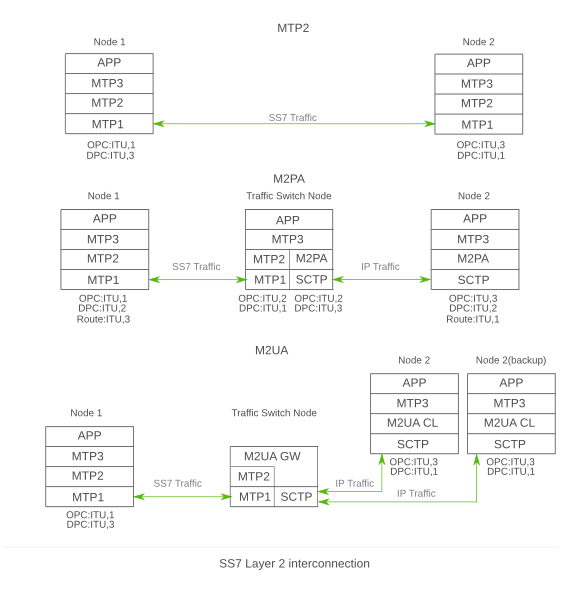M2PA VS M2UA
This document describes the differences between M2PA and M2UA.
The purpose of this document is to provide a better understanding of the differences and the similarities between this two protocols.
Similarities
- Both protocols represent a SIGTRAN SS7 layer 2 protocol
- They have the same functionality, to transport SS7 layer 3 messages over IP network.
- Both use SCTP as transport.
Differences
M2PA operates as a peer to peer protocol.
M2UA operates as in a gateway client model.
Each M2PA endpoint represents a SS7 node with it's own Point Code.
In M2UA only the client represents a SS7 node with a Point Code.
M2PA relays on SS7 layer 3 management procedures.
M2UA has his own management procedures.
On both M2PA nodes additional data processing can be done. E.G.: SCCP GT routing.
On M2UA gateway no additional data processing can be done because it has no SS7 layer 3 attached to it.
Each M2PA connection represents a SS7 link.
Each M2UA connection does not represents a link, instead represents an extension for remote data processing of a SS7 link.
If you have to choose for usage one of this two protocols the choice is not easy. When you make such a decision there are many factors that can influence it, like:
- SS7 network architecture
- Interconnection options
- Point Codes available
Usages
- SS7 network architecture.
Both protocols can be used to switch the traffic type from SS7 MTP1 based to IP based.
The choice here is based on:
- Data Processing.
- Data Processing.
If you want additional data processing at the switching end, let's say SCCP GT routing, you may want to use M2PA.
But if you just want to switch the traffic type you should use M2UA.
- Traffic unload.
Unlike M2PA, M2UA allows remote processing for SS7 layer 2 messages.
So if you have a high load SS7 node and you want to split it's load across different nodes you may want to use M2UA.
- Interconnection options.
If you have to choose one of this two protocols as a interconnection option you should base your decision on your SS7 network architecture and point codes available.
- Point Codes available
Unlike M2UA, M2PA requires a point code at each end. Witch means that if you want just traffic switching an additional point code will be required.
In this case if you want to spare a point code you should use M2UA.
The following image illustrates the traffic switching usage
In the image above we can see the following:
- In the MTP2 interconnection the layer 2 connection is peer to peer. Both endpoints representing a SS7 node with it's own point code but with no traffic switching.
- In the M2PA interconnection the layers 2 are also connected in a peer to peer model.
But for the traffic switch to be possible we have an intermediate node (Traffic Switch Node).
At the Traffic Switch Node we can see that there are two connection types.
One is old school SS7 signaling MTP1 + MTP2 link and one is SCTP + M2PA link.
Both links have a MTP3 layer above them, and this implies the allocation of an point code for this node.
The presence of MTP3 layer above the links offers the possibility of additional message processing at Application Layer. E.g.: SCCP Global Title routing.
- In the M2UA interconnection we have an classic SS7 MTP1+MTP2 connection and client server connection represented my the M2UA Gateway and both M2UA clients.
In this scenario each client act as backup for the other client.
As we can see, at the Traffic Switch Node, we do not have any upper SS7 layer above the M2UA gateway. This means that no point code is required for the Traffic switch node.
The MTP3 messages on the MTP2 link at the Traffic Switch Node are just encapsulated over M2UA protocol and delivered for processing to the MTP3 layer from the Node 2.
See also
